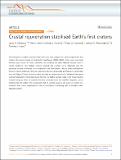Crustal rejuvenation stabilised Earth’s first cratons
Abstract
The formation of stable, evolved (silica-rich) crust was essential in constructing Earth’s first cratons, the ancient nuclei of continents. Eoarchaean (4000–3600 million years ago, Ma) evolved crust occurs on most continents, yet evidence for older, Hadean evolved crust is mostly limited to rare Hadean zircons recycled into younger rocks. Resolving why the preserved volume of evolved crust increased in the Eoarchaean is key to understanding how the first cratons stabilised. Here we report new zircon uranium-lead and hafnium isotope data from the Yilgarn Craton, Australia, which provides an extensive record of Hadean–Eoarchaean evolved magmatism. These data reveal that the first stable, evolved rocks in the Yilgarn Craton formed during an influx of juvenile (recently extracted from the mantle) magmatic source material into the craton. The concurrent shift to juvenile sources and onset of crustal preservation links craton stabilisation to the accumulation of enduring rafts of buoyant, melt-depleted mantle.
Citation
Mulder , J A , Nebel , O , Gardiner , N J , Cawood , P A , Wainwright , A N & Ivanic , T J 2021 , ' Crustal rejuvenation stabilised Earth’s first cratons ' , Nature Communications , vol. 12 , 3535 . https://doi.org/10.1038/s41467-021-23805-6
Publication
Nature Communications
Status
Peer reviewed
ISSN
2041-1723Type
Journal article
Description
This work was funded by Australian Research Council grant FL160100168 and Australian Research Council grant DP180100580.Collections
Items in the St Andrews Research Repository are protected by copyright, with all rights reserved, unless otherwise indicated.

